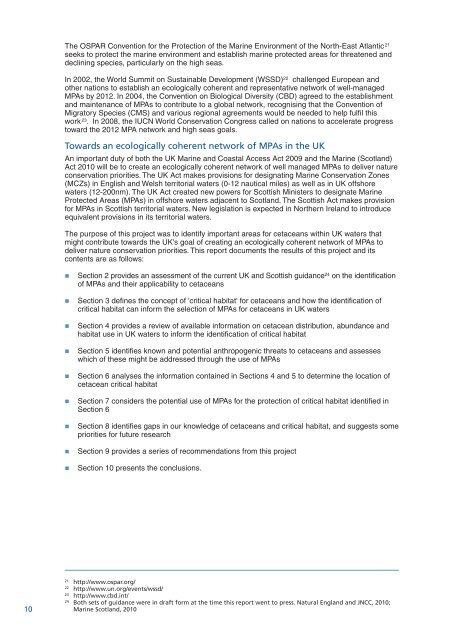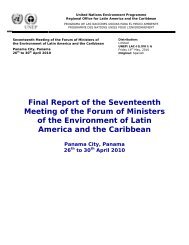English - Caribbean Environment Programme
English - Caribbean Environment Programme
English - Caribbean Environment Programme
- No tags were found...
Create successful ePaper yourself
Turn your PDF publications into a flip-book with our unique Google optimized e-Paper software.
The OSPAR Convention for the Protection of the Marine <strong>Environment</strong> of the North-East Atlantic 21seeks to protect the marine environment and establish marine protected areas for threatened anddeclining species, particularly on the high seas.In 2002, the World Summit on Sustainable Development (WSSD) 22 challenged European andother nations to establish an ecologically coherent and representative network of well-managedMPAs by 2012. In 2004, the Convention on Biological Diversity (CBD) agreed to the establishmentand maintenance of MPAs to contribute to a global network, recognising that the Convention ofMigratory Species (CMS) and various regional agreements would be needed to help fulfil thiswork 23 . In 2008, the IUCN World Conservation Congress called on nations to accelerate progresstoward the 2012 MPA network and high seas goals.Towards an ecologically coherent network of MPAs in the UKAn important duty of both the UK Marine and Coastal Access Act 2009 and the Marine (Scotland)Act 2010 will be to create an ecologically coherent network of well managed MPAs to deliver natureconservation priorities. The UK Act makes provisions for designating Marine Conservation Zones(MCZs) in <strong>English</strong> and Welsh territorial waters (0-12 nautical miles) as well as in UK offshorewaters (12-200nm). The UK Act created new powers for Scottish Ministers to designate MarineProtected Areas (MPAs) in offshore waters adjacent to Scotland. The Scottish Act makes provisionfor MPAs in Scottish territorial waters. New legislation is expected in Northern Ireland to introduceequivalent provisions in its territorial waters.The purpose of this project was to identify important areas for cetaceans within UK waters thatmight contribute towards the UK's goal of creating an ecologically coherent network of MPAs todeliver nature conservation priorities. This report documents the results of this project and itscontents are as follows:Section 2 provides an assessment of the current UK and Scottish guidance 24 on the identificationof MPAs and their applicability to cetaceansSection 3 defines the concept of 'critical habitat' for cetaceans and how the identification ofcritical habitat can inform the selection of MPAs for cetaceans in UK watersSection 4 provides a review of available information on cetacean distribution, abundance andhabitat use in UK waters to inform the identification of critical habitatSection 5 identifies known and potential anthropogenic threats to cetaceans and assesseswhich of these might be addressed through the use of MPAsSection 6 analyses the information contained in Sections 4 and 5 to determine the location ofcetacean critical habitatSection 7 considers the potential use of MPAs for the protection of critical habitat identified inSection 6Section 8 identifies gaps in our knowledge of cetaceans and critical habitat, and suggests somepriorities for future researchSection 9 provides a series of recommendations from this projectSection 10 presents the conclusions.1021http://www.ospar.org/22http://www.un.org/events/wssd/23http://www.cbd.int/24Both sets of guidance were in draft form at the time this report went to press. Natural England and JNCC, 2010;Marine Scotland, 2010
















